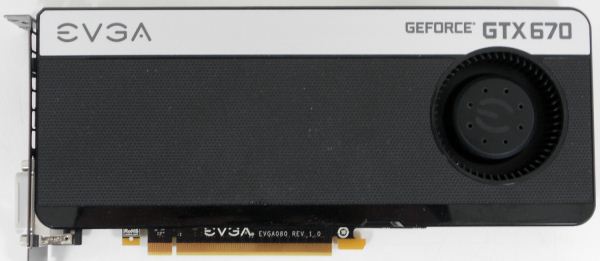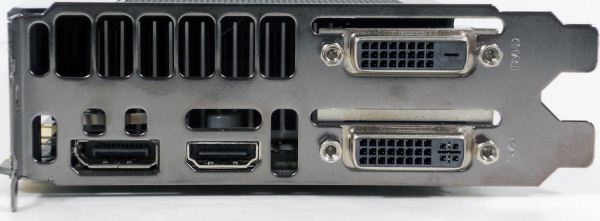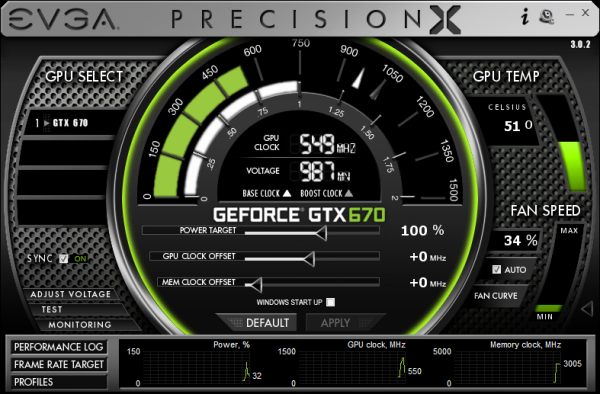NVIDIA GeForce GTX 670 Review Feat. EVGA: Bringing GK104 Down To $400
by Ryan Smith on May 10, 2012 9:00 AM ESTMeet The EVGA GeForce GTX 670 Superclocked
Our second card of the day is EVGA’s GeForce GTX 670 Superclocked, which in EVGA’s hierarchy is their first tier of factory overclocked cards. EVGA is binning GTX 670s and in turn promoting some of them to this tier, which means the GTX 670 Superclocked are equipped with generally better performing chips than the average reference card.
| GeForce GTX 670 Partner Card Specification Comparison | ||||
| EVGA GeForce GTX 670 Superclocked | GeForce GTX 670 (Ref) | |||
| CUDA Cores | 1344 | 1344 | ||
| Texture Units | 112 | 112 | ||
| ROPs | 32 | 32 | ||
| Base Clock | 967MHz | 915MHz | ||
| Boost Clock | 1046MHz | 980MHz | ||
| Memory Clock | 6210MHz | 6008MHz | ||
| Memory Bus Width | 256-bit | 256-bit | ||
| Frame Buffer | 2GB | 2GB | ||
| TDP | 170W | 170W | ||
| Manufacturing Process | TSMC 28nm | TSMC 28nm | ||
| Width | Double Slot | Double Slot | ||
| Length | 9.5" | 9.5" | ||
| Warranty | 3 Years | N/A | ||
| Price Point | $419 | $399 | ||
For the GTX 670 SC, EVGA has given both the core clock and memory clock a moderate boost. The core clock has been increased by 52MHz (6%) to 967MHz base and 66MHz (7%) boost to 1046MHz. Meanwhile the memory clock has been increased by 202MHz (3%) to 6210MHz.
Other than the clockspeed changes, the GTX 670 SC is an almost-reference card utilizing a reference PCB with a slightly modified cooler. EVGA is fabricating their own shroud, but they’ve copied NVIDIA’s reference shroud down to almost the last detail. The only functional difference is that the diameter of the fan intake is about 5mm less, otherwise the only difference is that EVGA has detailed it differently than NVIDIA and used some rounded corners in place of square corners.
The only other change you’ll notice is that EVGA is using their own high flow bracket in place of NVIDIA’s bracket. The high flow bracket cuts away as much metal as possible, maximizing the area of the vents. Though based on our power and temperature readings, this doesn’t seem to have notably impacted the GTX 670 SC.
While we’re on the matter of customized cards and factory overclocks, it’s worth reiterating NVIDIA’s position on factory overclocked cards. Reference and semi-custom cards (that is, cards using the reference PCB) must adhere to NVIDIA’s power target limits. For GTX 670 this is a 141W power target, with a maximum power target of 122% (170W). Fully custom cards with better power delivery circuitry can go higher, but not semi-custom cards. As a result the flexibility in building semi-custom cards comes down to binning. EVGA can bin better chips and use them in cards such as the Superclocked – such as our sample which can go 17 boost bins over the base clock versus 13 bins for our reference GTX 670 – but at the end of the day for stock performance they’re at the mercy of what can be accomplished within 141W/170W.
In any case, as the card is otherwise a reference GTX 670 EVGA is relying on the combination of their factory overclock, their toolset, and their strong reputation for support to carry the card. EVGA has priced the card at $419, $20 over the GTX 670 MSRP, in-line with other factory overclocked cards.
On the subject of pricing and warranties, since this is the first EVGA card we’ve reviewed since April 1st, this is a good time to go over the recent warranty changes EVGA has made.
Starting April 1st, EVGA has implemented what they’re calling their new Global Warranty Policy. Starting July 1st, 2011 (the policy is being backdated), all new EVGA cards ship with at least a 3 year warranty. And for the GTX 600 series specifically, so far EVGA has only offered models with a 3 year warranty in North America, which simplifies their product lineup.
To complement the 3 year warranty and replace the lack of longer term warranties, EVGA is now directly selling 2 and 7 year warranty extensions, for a total of 5 and 10 years respectively. So instead of buying a card with a 3 year warranty or a longer warranty, you’ll simply buy the 3 year card and then buy a warranty extension to go with it. However the extended warranty requires that the card be registered and the warranty purchased within 30 days.
The second change is that the base 3 year warranty no longer requires product registration. EVGA has other ways to entice buyers into registering, but they’ll now honor all applicable cards for 3 years regardless of the registration status. At the same time the base 3 year warranty is now a per-product warranty (e.g. a transferable warranty) rather than per-user warranty, so the base warranty will transfer to 2nd hand buyers. The extended warranties however will not.
The third change is how EVGA is actually going to handle the warranty process. First and foremost, EVGA is now allowing cards to be sent to the nearest EVGA RMA office rather than the office for the region the card was purchased from. For example a buyer moving from Europe to North America can send the card to EVGA’s North American offices rather than sending it overseas.
Finally, EVGA is now doing free cross shipping, alongside their existing Advanced RMA program. EVGA will now cross-ship replacement cards for free to buyers. The buyer meanwhile is responsible for paying to ship the faulty card back and putting up collateral on the new card until EVGA receives the old card.
There’s also one quick change to the step-up program that will impact some customers. With the move to purchasing extended warranties, the step-up program is only available to customers who either purchase an extended warranty or purchase an older generation card that comes with a lifetime warranty. Step-up is not available to cards with only the base 3 year warranty.
Moving on, along with EVGA’s new warranty EVGA is bundling the latest version of their GPU utilities, Precision X and OC Scanner X.
Precision X, as we touched upon quickly in our GTX 680 review, is the latest iteration of EVGA’s Precision overclocking & monitoring utility. It’s still based on RivaTuner and along with adding support for the GTX 600 series features (power targets, framerate caps, etc), it also introduces a new UI. Functionality wise it’s still at the top of the pack along with the similarly RivaTuner powered MSI Afterburner. Personally I’m not a fan of the new UI – circular UIs and sliders aren’t particularly easy to read – but it gets the job done.
OC Scanner X has also received a facelift and functionality upgrade of its own. Along with its basic FurMark-ish stress testing and error checking, it now also offers a basic CPU stress test and GPU benchmark.



















414 Comments
View All Comments
CeriseCogburn - Sunday, May 13, 2012 - link
28 isn't playable and yes, the nVidia card really wins that game, as we see in the 680 test, which I had to point out as you, the amd fanboy despite your claim to own a 680, never noticed like all the rest, including the author to a large degree, in the 680 release review here.So take your temporary Gaming Evolved amd game driver hack that disabled nVidia's winning sweep across all resolutions and celebrate, a fool of course needs to do so, you're welcome for pointing it out.
(roll eyes at the immense ignorance, again)
Now enjoy the video http://www.youtube.com/watch?v=J0eZEdpsgjk
I know amd told us many, many times, as did so many little named posters here for so many years, that nVidia was evil for TWIMTBP work and what they did to the amd cards performance in those efforts.
Maybe they should note this little problem that developed ?
ROFL
Galidou - Sunday, May 13, 2012 - link
''(roll eyes at the immense ignorance, again)''Such a troll again, such a lack of respect, indirect attacks, most useless comment on earth... immense ignorance, comon we're speaking about video cards, someone not knowing that you can change a buck for 4 quarters might be an ignorant... unless he's a tribal that lived in africa all his life... and then the ''again'' omg the inflammatory stuff you're able to say in 7 words sentence... I'm unsure you realize what you do... you're being really mean...
All that and I could only say you're mean... I guess respect ain't give to everyone, sad it can't be bought, because it must be the most important value, ALL AROUND, a man can have. Everything starts with respect, real wisdom is acquired through respect.
CeriseCogburn - Sunday, May 13, 2012 - link
All you do is attack, this is the last response you get from me unless you're on topic with a point, and as respectful as you demand others be, which you are not, you're the worst so far, a pure troll with no points at all.The other posters are trying to make points, not you. Attention for you is over.
Galidou - Sunday, May 13, 2012 - link
He mentions the puny 1,25gb because the card CAN'T run it and is usually a good performer against the competition at that resolution. You say it beats the 7870 in the next page, by 1-2 fps, I don't even call that a beating. Plus in a game that favors Nvidia.''This is the kind of crap we have to put up with here, at least we who have a brain and can see what's going on.''
I think you meant ''we who are Nvidia's fanboys''
It may not be the most neutral of comments but it's not the worst, you're just looking to find things against Nvidia and enumerate them because that's what Nvidia's fanboys do. What do they do, get mad as soon as there's a little reason to.
CeriseCogburn - Sunday, May 13, 2012 - link
No other card can run it with gaming frame rates in his test.Since he didn't point that out, I DID.
I guess he'll have to work harder to find a valid reason to dis the card since he has claimed nVidia is keeping it on, and the egg sure looks like that is correct - a lot of stock present.
Now, you validated my point, but want to call it petty, but a similar thing happens on nearly every gaming page.
At least what I point out is some pathetic grammar nazi problem, huh, which all of the rest of you seem to love to do so much, in every review posting it appears to be a contest for that, and I agree with the reviewer that PM'ing him to offer a correction is actually adult like and responsible.
That of course is different than what bothers me, and we shall see, a valid complaint is usually responded to in a good way, so there may be some thought ahead, I certainly expect positive results for my efforts.
As is so often claimed here by those in charge they respond to readers and what they want, so this fits that case fine.
On that note along those lines I already advocated a single gaming chart with the collated data of the various cards in their overclocked performance states, as it seems to me that would be a nice added feature to reviews and would settle some of the rancor on the reviewed cards sometimes having OC'ed versions added in their release.
SamsungAppleFan - Thursday, May 10, 2012 - link
first of all, thanks for the article, but you guys (anandtech) take wayyyyyy too long between new articles. get on it guys, seriously. and i'm still waiting on my gs3 full review lol.GlItCh017 - Thursday, May 10, 2012 - link
This card can really shine if it likes what you like. I'm a huge FPS fan, so in scenario's such as BF3 the GTX 670 vs. Radeon HD 6970 is a no brainer.Morg. - Thursday, May 10, 2012 - link
Sure, like most FPS's won't be on Unreal4 instead of frostbite ;)That engine, for some reason, favors nVidia and I don't think it's a good GPU performance metric, although if you're going to play frostbite content, it's clearly important.
Morg. - Thursday, May 10, 2012 - link
Nevermind, I knew why but I hadn't seen it mentioned yet.http://www.geforce.com/whats-new/articles/johan-an...
So .. buying a graphics board because it is favored by a botched graphical engine which is temporary - meh. If you plan on keeping your pc 2 or 3 years, fck the marketing, get raw power instead ;)
antef - Thursday, May 10, 2012 - link
Are you saying AMD has the better GPU for most FPS titles outside ones running Frostbite?